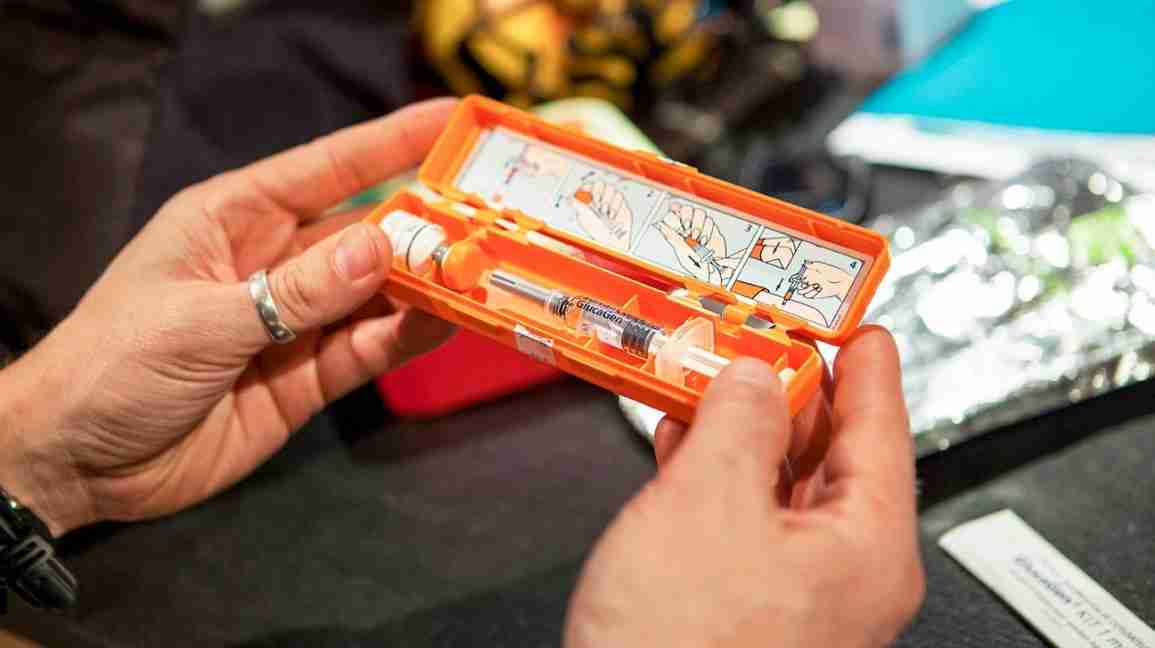If you or someone you know has type 1 diabetes, you’re likely familiar with low blood sugar, or hypoglycemia. Sweatiness, confusion, dizziness, and extreme hunger are some of the signs and symptoms that occur when blood sugar drops below 70 mg/dL (4 mmol/L).
Most of the time, a person with diabetes can treat low blood sugar on their own. However, if it isn’t treated promptly, low blood sugar can become a medical emergency.
Hypoglycemia is considered severe when a person’s blood sugar drops so low that they need assistance from someone else to help them recover. This may involve using a medication called glucagon.
Your liver stores extra glucose in your body for situations when blood sugar drops too low. Your brain relies on glucose for energy, so it’s important that this energy source can be made available fast.
Glucagon is a hormone made in the pancreas. In a person with diabetes, natural glucagon doesn’t work properly. Glucagon medication can help trigger the liver to release the stored glucose.
When your liver releases the glucose it stored, your blood sugar levels quickly rise.
If you have type 1 diabetes, your doctor may recommend that you purchase a glucagon kit in case of an episode of severe low blood sugar. When someone experiences severe low blood sugar, they need someone else to give them glucagon.
In a person without diabetes, the hormones insulin and glucagon work together to tightly regulate blood sugar levels. Insulin works to lower blood sugar and glucagon triggers the liver to release stored sugar to raise blood sugar levels. In a person without diabetes, insulin release also stops when blood sugar is dropping.
In a person with type 1 diabetes, insulin-producing cells in the body are damaged, so insulin must be injected using needles or an insulin pump. Another challenge in type 1 diabetes is that within
That’s why glucagon is available as a medication to assist in cases of severe hypoglycemia, when a person isn’t able to treat themselves. Glucagon medication triggers the release of glucose from the liver to increase blood sugar levels, just as the natural hormone is supposed to do.
There are currently two types of injectable glucagon medication available in the United States. These are only available by prescription:
In July 2019, the FDA approved a glucagon nasal powder called
If you have glucagon medication, make sure to regularly check the expiration date. Glucagon is good for 24 months after the date of manufacture. Glucagon should be stored at room temperature, away from direct light.
When a person with type 1 diabetes can’t treat their own low blood sugar, they may need glucagon. The medication may be used when a person is:
- not responsive
- unconscious
- refusing to drink or swallow a source of sugar by mouth
Never try to force a person to eat or drink a source of sugar because the person could choke. If you’re not sure whether to use glucagon, be aware that it’s virtually impossible for a person to overdose on glucagon. In general, if you’re uncertain, it’s better to give it.
If a person is experiencing a severe hypoglycemic episode, call 911 or your local emergency number for medical help right away.
To treat severe hypoglycemia using a glucagon kit, follow these steps:
- Open the glucagon kit. It will contain a syringe (needle) filled with saline liquid and a small bottle of powder. The needle will have a protective top on it.
- Remove the cap from the bottle of powder.
- Remove the needle’s protective top and push the needle all the way into the bottle.
- Push all of the saline liquid from the needle into the bottle of powder.
- Gently swirl the bottle until the glucagon powder dissolves and the liquid is clear.
- Follow the dosing instructions on the kit to draw the correct amount of glucagon mixture into the needle.
- Inject the glucagon into the person’s outer mid-thigh, upper arm, or buttock. It’s fine to inject through fabric.
- Roll the person to their side, positioning their top knee at an angle (as if they are running) to stabilize them. This is also known as “recovery position.”
Never give a person glucagon by mouth because it won’t work.
For both types of injectable glucagon the
- 0.5 mL of glucagon solution for children 5 years and younger, or children who weigh less than 44 lbs.
- 1 mL glucagon solution, which is the full contents of a glucagon kit, for children 6 years and older and adults
The nasal powder form of glucagon comes in a single use dose of 3 mg.
The side effects of glucagon are generally minor. Some people may experience nausea or vomiting after using injectable glucagon.
Keep in mind that nausea and vomiting may also be symptoms of severe hypoglycemia. It may be hard to know whether someone is experiencing a side effect of glucagon or a symptom related to severe hypoglycemia.
In addition to nausea and vomiting, the
- watery eyes
- nasal congestion
- irritation of the upper respiratory tract
If symptoms of nausea and vomiting prevent someone from eating or drinking a source of sugar after they’ve had glucagon, seek medical attention.
It can take up to 15 minutes for a person to wake up after receiving glucagon. If they’re not awake after 15 minutes, they need emergency medical assistance. They can also receive another dose of glucagon.
Once they’re awake, they should:
- check their blood sugar levels
- consume a source of 15 grams of quick-acting sugar, such as soda or juice containing sugar, if they can safely swallow
- eat a small snack such as crackers and cheese, milk or a granola bar, or eat a meal within the hour
- monitor their blood sugar levels at least every hour for the next 3 to 4 hours
Anyone who experiences severe low blood sugar that requires treatment with glucagon should talk to their doctor about the episode. It’s also important to get a replacement glucagon kit right away.
If low blood sugar is treated promptly, it won’t usually drop low enough to be considered severe. Glucagon is only needed in cases of severe hypoglycemia, when a person isn’t able to treat the condition themselves.
In most cases, a person with diabetes can treat low blood sugar on their own or with minimal help. The treatment is to consume 15 grams of fast-acting carbohydrates, such as:
- ½ cup juice or soda that contains sugar (not diet)
- 1 tablespoon honey, corn syrup, or sugar
- glucose tablets
Following treatment, it’s important to wait 15 minutes and then recheck your blood sugar levels. If your blood sugar levels are still low, consume another 15 grams of carbohydrates. Continue doing this until your blood sugar is above 70 mg/dL (4 mmol/L).
Many cases of hypoglycemia can be self-managed, but it’s important to be prepared. Severe hypoglycemia needs to be treated with glucagon.
You might consider wearing a medical ID. You should also tell the people you spend the most time with that you have type 1 diabetes and where to find your glucagon treatment.
Reviewing the steps for using glucagon medication with others may help you feel more comfortable in the long term. You’ll know that someone has the skills to help you if you ever need it.

